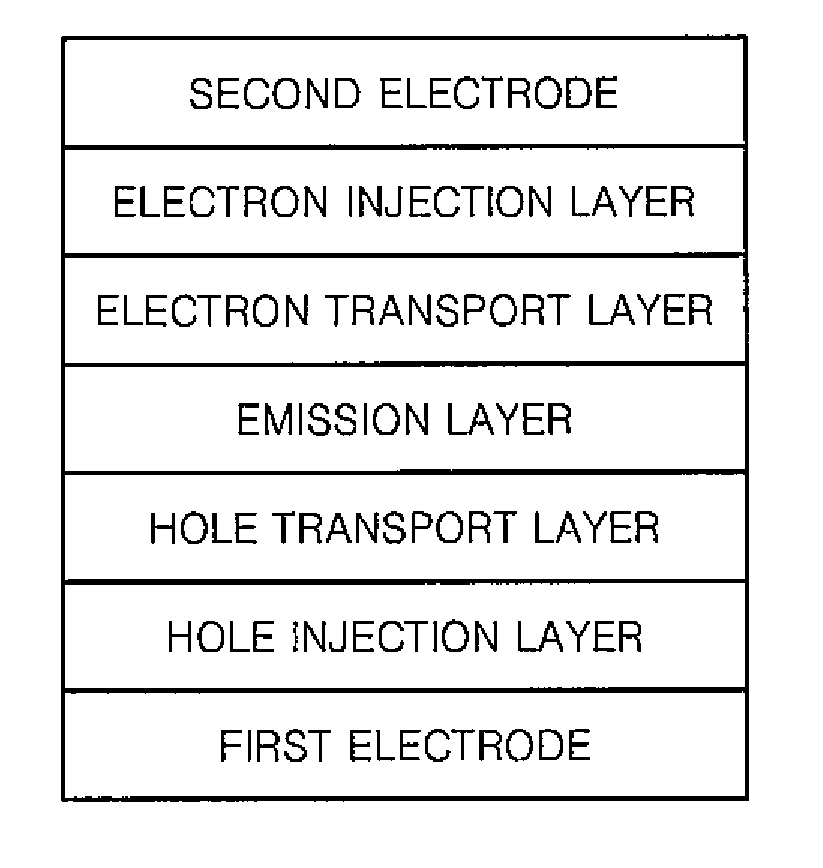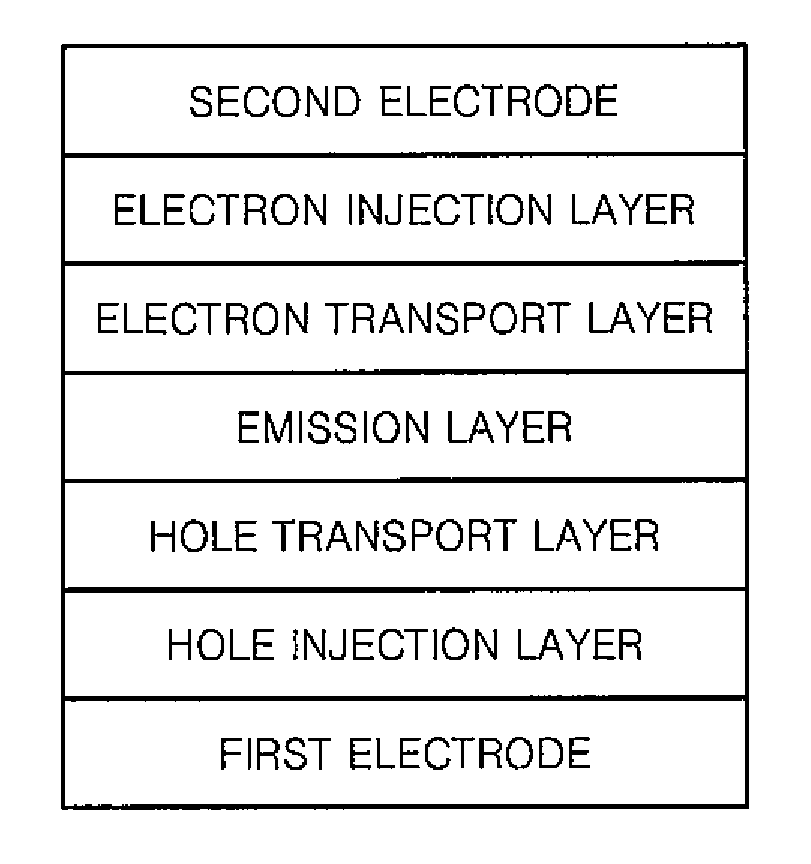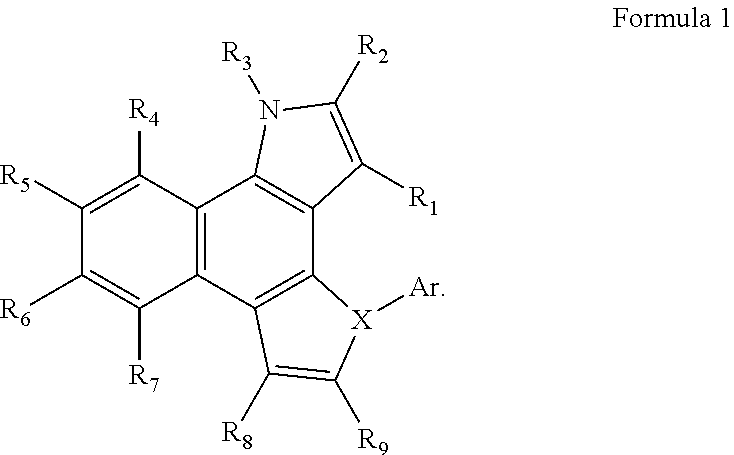Compound and organic light emitting device comprising the same
a light-emitting device and compound technology, applied in the direction of organic chemistry, luminescent compositions, natural mineral layered products, etc., can solve the problems of poor thermal stability, no substantial enhancement in regards to electric power efficiency, and the life of the oled using phosphorescent materials is not satisfactory, so as to improve the emission efficiency and device life, improve the effect of skeletal structure and excellent skeletal structur
- Summary
- Abstract
- Description
- Claims
- Application Information
AI Technical Summary
Benefits of technology
Problems solved by technology
Method used
Image
Examples
example
Synthesis Example 1
[0168]
Synthesis of Intermediate A-3
[0169]10 g (1 eq, 0.048 mol) of A-1 and 14.06 g (1.1 eq, 0.049 mol) of A-2 were added to a flask and dissolved in 700 ml of toluene. 0.08 g (0.03 eq, 0.000144 mmol) of Pd2(dba)3, 4.27 g (1.2 eq, 0.057 mol) of Na(t-bu)O, and 0.07 g (0.06 eq, 0.00288 mmol) of P(t-Bu)3 were added to the flask and dissolved in 150 ml of additional toluene to prepare a mixture, and the mixture was thermally agitated for 12 hours to prepare a reaction solution. The reaction solution was filtered through Celite and then subjected to a column chromatography to obtain 14.7 g (yield rate=84.2%) of Compound 1.
[0170]Elemental Analysis for C24H16N4: calcd C, 79.98; H, 4.47; N, 15.55.
[0171]HRMS for C24H16N4 [M]+: calcd 360.14. found 360.
Synthesis of Compound 1
[0172]8 g (1 eq, 0.022 mol) of A-3 and 7.84 g (1.1 eq, 0.0242 mol) of A-4 were added to a flask and dissolved in 500 ml of Toluene. 0.08 g (0.03 eq, 0.000144 mmol) of Pd2(dba)3, 4.27 g (1.2 eq, 0.057 mol)...
synthesis example 2
[0175]
Synthesis of Compound 2
[0176]10 g (1 eq, 0.019 mol) of B-1 and 3.58 g (1.1 eq, 0.0214 mol) of B-2 were added to a flask and dissolved in 450 ml of Toluene. 0.52 g (0.03 eq, 0.00057 mmol) of Pd2(dba)3, 3.79 g (1.2 eq, 0.022 mol) of Na(t-bu)O, and 1.57 g (0.06 eq, 0.0114 mmol) of P(t-Bu)3 were added to the flask and dissolved in 150 ml of additional toluene to prepare a mixture, and the mixture was thermally agitated for 12 hours to prepare a reaction solution. The reaction solution was filtered through Celite and then subjected to a column chromatography to obtain 9.0 g (yield rate=79%) of Compound 2.
[0177]Elemental Analysis for C43H28N4: calcd C, 85.98; H, 4.70; N, 9.33.
[0178]HRMS for C43H28N4 [M]+: calcd 600.23. found 600.
synthesis example 3
[0179]
[0180]10 g (1 eq, 0.022 mol) of C-1 and 7.8 g (2.2 eq, 0.05 mol) of C-2 were added to a flask and dissolved in 300 ml of Toluene. 0.64 g (0.03 eq, 0.00066 mmol) of Pd2(dba)3, 6.59 g (2.2 eq, 0.05 mol) of Na(t-bu)O, and 1.22 g (0.06 eq, 0.0132 mmol) of P(t-Bu)3 were added to the flask and dissolved in 150 ml of additional toluene to prepare a mixture, and the mixture was thermally agitated for 12 hours to prepare a reaction solution. The reaction solution was filtered through Celite and then subjected to a column chromatography to obtain 10.9 g (yield rate=85%) of Compound 4.
[0181]Elemental Analysis for C43H29N3: calcd C, 87.88; H, 4.97; N, 7.15.
[0182]HRMS for C43H29N3 [M]+: calcd 587.24. found 587.
PUM
| Property | Measurement | Unit |
|---|---|---|
| pressure | aaaaa | aaaaa |
| temperature | aaaaa | aaaaa |
| temperature | aaaaa | aaaaa |
Abstract
Description
Claims
Application Information
 Login to View More
Login to View More - R&D
- Intellectual Property
- Life Sciences
- Materials
- Tech Scout
- Unparalleled Data Quality
- Higher Quality Content
- 60% Fewer Hallucinations
Browse by: Latest US Patents, China's latest patents, Technical Efficacy Thesaurus, Application Domain, Technology Topic, Popular Technical Reports.
© 2025 PatSnap. All rights reserved.Legal|Privacy policy|Modern Slavery Act Transparency Statement|Sitemap|About US| Contact US: help@patsnap.com



